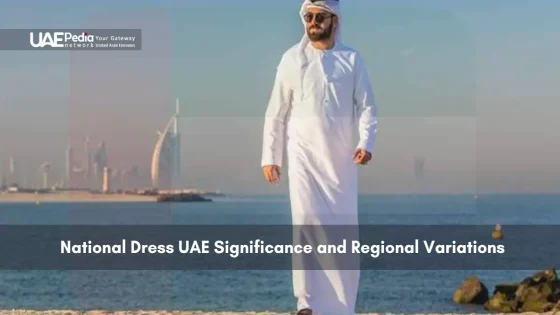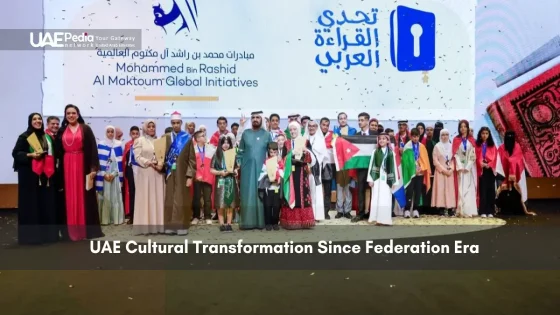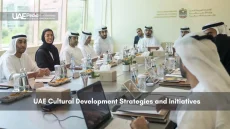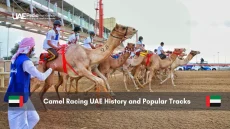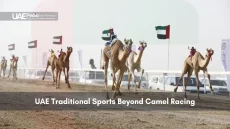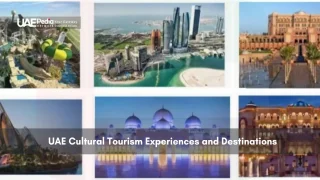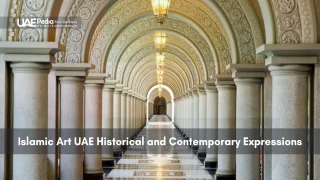What if the story of a nation wasn’t just written in history books but woven into palm fronds and etched into clay? Behind the UAE’s gleaming skylines lies a thriving world where artisans transform desert-grown materials into functional art—tableclorns that whisper Bedouin poetry, bags blending geometric precision with camel-wool warmth, and pottery shaped by techniques older than Dubai’s tallest towers.
Generations of makers keep heritage alive through practices like Al Sadu weaving—a rhythmic dance of threads creating symbolic patterns—and Al Khous, where palm leaves become baskets echoing ancient trade routes. These traditional Emirati crafts aren’t museum relics. They’re living traditions, reimagined as modern home décor and fashion statements while honoring their roots.
Every stitch and coil tells dual tales: one of nomadic survival skills adapted to today’s design trends, another of cultural identity preserved through hands-on work. From Abu Dhabi’s heritage festivals to Ras Al Khaimah’s workshops, artisans prove that history isn’t just remembered—it’s crafted daily.
Key threads to follow:
- How age-old weaving and pottery methods shape contemporary products
- The hidden symbolism in geometric textile designs
- Why supporting local artisans strengthens cultural heritage
Introduction to the Rich Heritage of Emirati Crafts
The heartbeat of Emirati culture pulses through the skilled hands of its artisans, weaving tales of the past into the present. Picture this: nomadic tribes trading intricately patterned textiles along ancient caravan routes, their designs mapping survival secrets and celestial patterns. These crafts didn’t just endure—they evolved, blending Bedouin ingenuity with influences from coastal traders and mountain dwellers.
Historical Background of Emirati Handicrafts
Centuries ago, date palm fibers became baskets sturdy enough for desert journeys. Clay from wadi beds transformed into water jars that kept drinks cool under relentless sun. Sword-making techniques—honed for protection—now inspire decorative motifs in modern jewelry. Each craft began as necessity, then grew into art that whispers stories of resilience.
Cultural Significance in Daily Lives
You’ll still find grandmothers teaching Al Sadu weaving to wide-eyed grandchildren, their looms clicking like metronomes keeping time with tradition. Weddings feature henna designs rooted in heritage, while homes display pottery engraved with symbols once guiding lost travelers. As one Ras Al Khaimah artisan told me: “Our hands remember what our minds might forget.”
Today, initiatives like preserving Emirati heritage ensure these skills thrive beyond museum walls. From souq stalls to luxury collaborations, every piece bridges generations—proving culture isn’t static, but a living tapestry we’re all invited to hold.
Handicrafts UAE: Traditional Techniques and Their Modern Adaptations
Imagine holding a palm leaf transformed into an elegant clutch purse—its geometric patterns mirroring constellations once guiding desert caravans. This is where ancient technique meets millennial pink trends, proving heritage craftsmanship never truly ages.
Overview of Time-Honored Craft Methods
Al Sadu weaving isn’t just threading wool—it’s coding stories. Artisans use vertical looms to create symbolic zigzags representing mountain paths. Nearby, blacksmiths hammer silver into ceremonial daggers using Al-Saifah methods unchanged since pearl-diving eras.
Clay pots still begin as coils pressed thumb-width at a time. But now, modern glazes turn them into minimalist planters snapped up by Dubai design studios. “We shape the past to hold tomorrow’s dreams,” explains a Fujairah potter.
Global Influences and Contemporary Twists
Tokyo meets Abu Dhabi in handwoven rugs blending camel-hair textures with Japanese boro mending. Scandinavian furniture brands collaborate with Emirati weavers, transforming palm-frond baskets into pendant lamps.
Social media reshapes markets too. Young artisans now laser-engrave poetry onto ceramic mugs while preserving hand-painting techniques. The result? Objects that feel equally at home in Bedouin tents or Brooklyn lofts.
As one Sharjah workshop leader puts it: “Tradition isn’t a cage—it’s the wind beneath new ideas.” From 3D-printed jewelry inspired by falconry gear to upcycled fishing net totes, these crafts prove cultural roots grow strongest when nourished by fresh perspectives.
How to Create Authentic Emirati Crafts at Home
Ever wanted to weave stories with your hands? Let’s roll up our sleeves and dive into simple projects that connect you to generations of makers. With a few basic tools and patience, you’ll craft products that blend cultural identity with your personal touch.
Step-by-Step Guide for Beginners
Start with palm-leaf coasters—a perfect entry point. Local artisans suggest soaking dried fronds overnight to soften them. Twist two strands into figure-eight loops, securing ends with natural twine. “The rhythm matters more than perfection,” says Aisha, a Ras Al Khaimah weaver.
| Tools | Materials | Where to Find |
|---|---|---|
| Wooden loom | Palm leaves | Local date farms |
| Clay tools | Terracotta clay | Abu Dhabi craft stores |
| Embroidery hoop | Camel-wool thread | Online marketplaces |
For miniature pottery, knead air bubbles out of clay before shaping. Use a thumb-press technique to create coil-built bowls. Let pieces dry under shade—direct sun cracks material faster than you’d expect!
Try geometric embroidery next. Trace designs inspired by desert dunes onto linen. Stitch using double-running technique for reversible patterns. Dubai-based artisans recommend starting with ochre and indigo threads—colors echoing the country’s landscapes.
Share your creations online using #MyEmiratiCraft. Tag local workshops—many repurpose fan-made products into collaborative installations. Remember, every crooked stitch or lopsided bowl carries the beauty of hands learning ancestral skill.
Navigating Vibrant Local Markets and Cultural Identity
Step into a market where incense swirls around displays of geometric textiles, and the clink of pottery echoes centuries of trade. These bustling spaces aren’t just shopping spots—they’re living galleries where culture breathes through every stall.
Exploring Artisan Markets in the UAE
Dubai’s Al Fahidi district hums with energy—weavers demonstrate palm-frond basket coiling while modern boutiques showcase camel-wool scarves. In Abu Dhabi, the Women’s Handicraft Center reveals artisans etching silver designs inspired by desert dunes. “Our markets are conversations between old and new,” says a vendor arranging date-patterned ceramics beside neon-lit lanterns.
Tips for Identifying Authentic Craftsmanship
Look for slight imperfections—handmade items often show natural variations. Genuine palm-leaf baskets feel slightly rough, while mass-produced versions lack earthy scents. Check for artist signatures or workshop stamps on pottery bases.
| Authentic Clues | Mass-Produced Signs |
|---|---|
| Visible tool marks | Perfect symmetry |
| Natural material textures | Plastic-like finishes |
| Local material sourcing | Generic packaging |
Blending Tradition with Modern Design
Spot terracotta vases dipped in metallic glazes at Sharjah’s Blue Souk. Designers rework Bedouin tent patterns into linen throws that suit Manhattan lofts. As one Ajman creator explains: “We’re not erasing history—we’re writing new chapters with familiar ink.”
Your purchases here do more than decorate homes—they keep ancestral skills alive. Next time you bargain for embroidered cushions or palm-wood trays, remember: you’re carrying forward stories older than the arab emirates’ tallest skyscrapers.
Empowering Artisans and Preserving Traditional Craftsmanship
What if every woven basket could fund a child’s education? Across the Emirates, grassroots movements are turning age-old skills into engines of opportunity. Organizations like Irthi Contemporary Crafts Council partner with women artisans, transforming palm-frond weaving into sustainable income streams. Their heritage preservation initiatives blend commerce with cultural pride—proving tradition can thrive in modern markets.
Initiatives Supporting Local Artisan Communities
Tashkeel’s design labs connect Bedouin weavers with urban architects. Together, they reimagine camel-wool textiles as acoustic wall panels for luxury hotels. These collaborations create jobs while keeping techniques alive. One Ras Al Khaimah weaver shares: “My grandmother’s stitches now decorate skyscrapers—that’s real power.”
| Program | Focus | Impact |
|---|---|---|
| Irthi Craft Circles | Palm-based crafts | 650+ women trained |
| Tashkeel Labs | Modern material fusion | 23 product lines launched |
| Design Campus Ajman | Pottery innovation | 45% sales increase |
Educational Programs and Skill Development
Free workshops teach teens to shape clay using both ancient coil methods and 3D printers. In Sharjah, grandmothers earn certifications in natural dye-making—skills dating back to pearl-diving eras. “Education isn’t just about new techniques,” explains an Irthi mentor. “It’s showing why our crafts matter in a changing world.”
These efforts ensure cultural knowledge becomes a living part of daily life. When tourists buy laser-etched pottery or architects specify palm-fiber insulation, they’re not just purchasing art—they’re sustaining stories.
Final Reflections on the Legacy and Future of Emirati Handicrafts
In every coiled palm fiber lies a conversation between generations—a dialogue where ancient symbols meet modern minimalism. The crafts we’ve explored aren’t frozen in time. They’re breathing entities, shaped by desert winds and global tastes alike.
From Bedouin weaving patterns guiding today’s interior designers to clay techniques inspiring eco-friendly tableware, this country’s heritage thrives through reinvention. Artisans now source material from urban gardens and recycled metals while keeping ancestral methods intact. It’s proof that history doesn’t weigh down creativity—it gives it wings.
Your morning coffee might someday steam in a palm-leaf mug, its grooves echoing caravan routes. That’s the magic here: daily lives become galleries for living traditions. Global collectors snap up camel-wool throws not just for warmth, but for the stories stitched into their geometric identity.
As the United Arab Emirates strides forward, its artisans remind us that progress grows deepest when rooted in palm trees and shared memory. Whether you’re marveling at a ceramic vase or a carved camel figurine, remember—you’re holding a piece of a world where innovation walks hand-in-hand with ancestry, step by deliberate step.
Techniques like sadu weaving (using camel or goat wool) and palm frond braiding trace back to desert life – creating functional items like tents, mats, and storage jars. Patterns often mimic dunes, animals, or constellations, embedding stories of survival and community into everyday objects.
Artisans rely on date palm leaves for baskets, clay for pottery like "jars" for water cooling, and dyed wool for textiles. Modern makers sometimes blend recycled metals or acrylics while keeping ancestral methods alive – think palm fiber coasters with gold leaf accents.
Hit Dubai’s Global Village for regional crafts or Abu Dhabi’s House of Artisans for workshops. Weekly markets in Sharjah and Ras Al Khaimah showcase embroidery, ceramics, and aromatic "bakhoor" incense. Look for items with slight imperfections – machine-made copies lack that human touch!
Absolutely! Start with palm leaf weaving – soak fronds overnight, then fold into coasters or trays. YouTube tutorials from UAE cultural channels break down basics. For textiles, practice geometric "talli" braiding using colorful threads. Local craft stores in Al Ain even sell beginner kits.
Programs like Abu Dhabi’s Cultural Foundation host elder artisans teaching pottery throwing and metal engraving. Schools now include craft modules, while Dubai Design Week spotlights modern reinterpretations – like 3D-printed "sadu" patterns on lampshades. Your purchases at heritage markets directly support these efforts!

